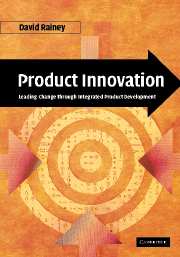Book contents
- Frontmatter
- Contents
- Preface
- Acknowledgements
- Part I Product innovation and strategic logic
- Part II Establishing the foundation: the conceptual level
- Part III Methods and techniques for analysis and decision making
- 7 Product/market considerations, integrated product design, and product architecture
- 8 Marketing strategies and methods: conceptualizing and designing the new-product marketing campaign
- 9 Production strategies and methods: operational and manufacturing implications
- 10 Financial applications and implications
- Part IV The operational level and concluding remarks
- Glossary
- References
- Select bibliography
- Index
10 - Financial applications and implications
Published online by Cambridge University Press: 10 August 2009
- Frontmatter
- Contents
- Preface
- Acknowledgements
- Part I Product innovation and strategic logic
- Part II Establishing the foundation: the conceptual level
- Part III Methods and techniques for analysis and decision making
- 7 Product/market considerations, integrated product design, and product architecture
- 8 Marketing strategies and methods: conceptualizing and designing the new-product marketing campaign
- 9 Production strategies and methods: operational and manufacturing implications
- 10 Financial applications and implications
- Part IV The operational level and concluding remarks
- Glossary
- References
- Select bibliography
- Index
Summary
Introduction
This chapter focuses on the financial methods and techniques used during the new-product development (NPD) process and their applications and implications. The purpose of the discussions is to provide an overview of the essential elements of selected quantitative methods to assess new-product opportunities and programs from a financial perspective. The theories and concepts outlined in the supplement to Chapter 6 established the foundations for the content discussed in this chapter. The content of the chapter covers several important financial techniques that are imperative for making effective decisions during the NPD process.
The chapter flows from the specifics of determining unit costs to the broader perspectives of assessing the financial implications of the NPD program. The essential question for any new product is: Does the new product generate and sustain sufficient value for the participants involved in the process and their constituents to justify the time, money and effort, i.e. the investment? Moreover, the question revolves around the overarching view of the “reward-to-risk” relationship. Are the rewards worth the risks? The answers are complex and depend on the circumstances of the business environment, and the capabilities and resources of the enterprise.
New-product development is inherently risky. Even the most well-understood NPD situations and well-articulated NPD processes have many unknowns and uncertainties. Every development decision has the potential to create problems and liabilities or, on the other hand, to achieve great successes.
- Type
- Chapter
- Information
- Product InnovationLeading Change through Integrated Product Development, pp. 432 - 466Publisher: Cambridge University PressPrint publication year: 2005



